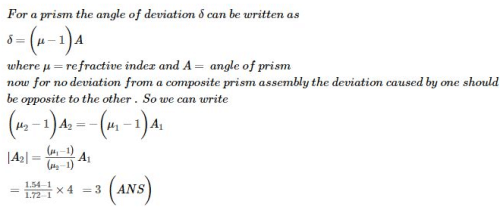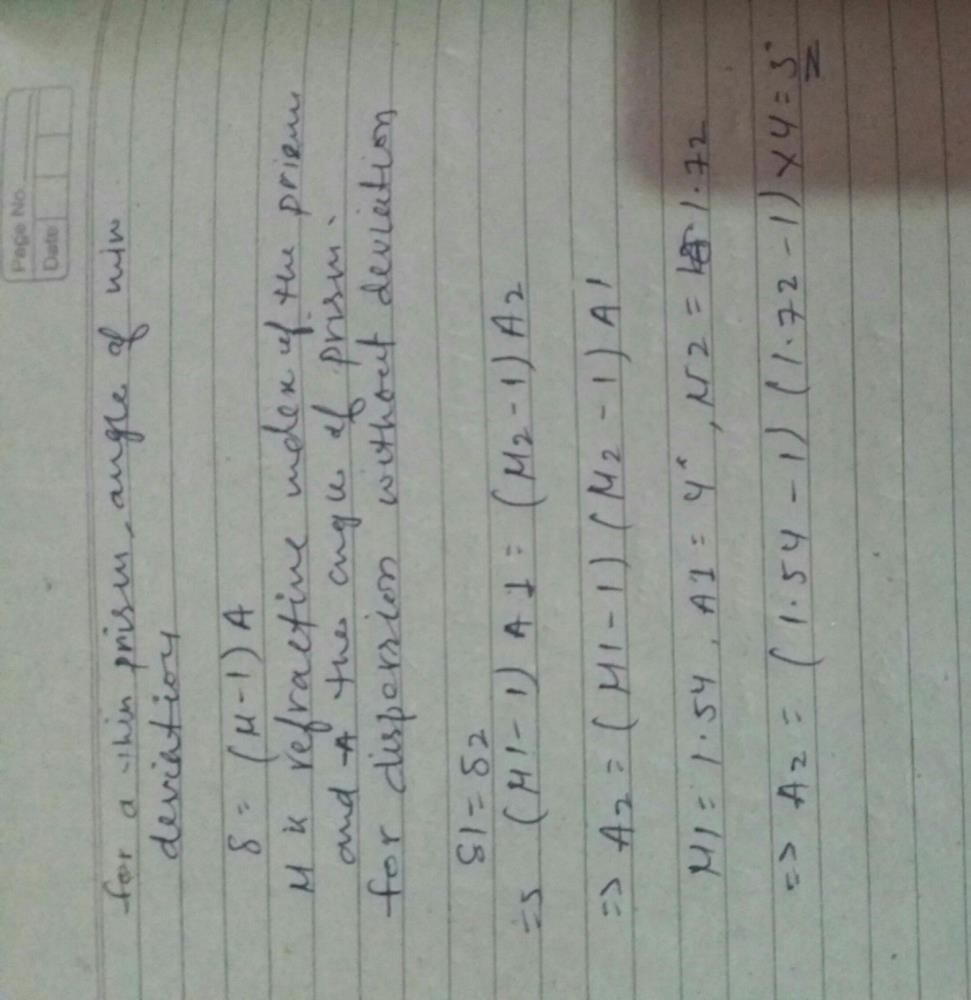Class 12 Exam > Class 12 Questions > A thin prism P1with angle 4° and made fr...
Start Learning for Free
A thin prism P1 with angle 4° and made from glass of refractive index 1.54 is combined with another thin prism P2 made from glass of refractive index 1.72 to produce dispersion without deviation . The angle of prism P2 is:
- a)5.33°
- b)2.6°
- c)3°
- d)4°
Correct answer is option 'C'. Can you explain this answer?
Most Upvoted Answer
A thin prism P1with angle 4° and made from glass of refractive in...

Free Test
FREE
| Start Free Test |
Community Answer
A thin prism P1with angle 4° and made from glass of refractive in...


|
Explore Courses for Class 12 exam
|

|
Question Description
A thin prism P1with angle 4° and made from glass of refractive index 1.54 is combined with another thin prism P2made from glass of refractive index 1.72 to produce dispersion without deviation . The angle of prism P2is:a)5.33°b)2.6°c)3°d)4°Correct answer is option 'C'. Can you explain this answer? for Class 12 2025 is part of Class 12 preparation. The Question and answers have been prepared according to the Class 12 exam syllabus. Information about A thin prism P1with angle 4° and made from glass of refractive index 1.54 is combined with another thin prism P2made from glass of refractive index 1.72 to produce dispersion without deviation . The angle of prism P2is:a)5.33°b)2.6°c)3°d)4°Correct answer is option 'C'. Can you explain this answer? covers all topics & solutions for Class 12 2025 Exam. Find important definitions, questions, meanings, examples, exercises and tests below for A thin prism P1with angle 4° and made from glass of refractive index 1.54 is combined with another thin prism P2made from glass of refractive index 1.72 to produce dispersion without deviation . The angle of prism P2is:a)5.33°b)2.6°c)3°d)4°Correct answer is option 'C'. Can you explain this answer?.
A thin prism P1with angle 4° and made from glass of refractive index 1.54 is combined with another thin prism P2made from glass of refractive index 1.72 to produce dispersion without deviation . The angle of prism P2is:a)5.33°b)2.6°c)3°d)4°Correct answer is option 'C'. Can you explain this answer? for Class 12 2025 is part of Class 12 preparation. The Question and answers have been prepared according to the Class 12 exam syllabus. Information about A thin prism P1with angle 4° and made from glass of refractive index 1.54 is combined with another thin prism P2made from glass of refractive index 1.72 to produce dispersion without deviation . The angle of prism P2is:a)5.33°b)2.6°c)3°d)4°Correct answer is option 'C'. Can you explain this answer? covers all topics & solutions for Class 12 2025 Exam. Find important definitions, questions, meanings, examples, exercises and tests below for A thin prism P1with angle 4° and made from glass of refractive index 1.54 is combined with another thin prism P2made from glass of refractive index 1.72 to produce dispersion without deviation . The angle of prism P2is:a)5.33°b)2.6°c)3°d)4°Correct answer is option 'C'. Can you explain this answer?.
Solutions for A thin prism P1with angle 4° and made from glass of refractive index 1.54 is combined with another thin prism P2made from glass of refractive index 1.72 to produce dispersion without deviation . The angle of prism P2is:a)5.33°b)2.6°c)3°d)4°Correct answer is option 'C'. Can you explain this answer? in English & in Hindi are available as part of our courses for Class 12.
Download more important topics, notes, lectures and mock test series for Class 12 Exam by signing up for free.
Here you can find the meaning of A thin prism P1with angle 4° and made from glass of refractive index 1.54 is combined with another thin prism P2made from glass of refractive index 1.72 to produce dispersion without deviation . The angle of prism P2is:a)5.33°b)2.6°c)3°d)4°Correct answer is option 'C'. Can you explain this answer? defined & explained in the simplest way possible. Besides giving the explanation of
A thin prism P1with angle 4° and made from glass of refractive index 1.54 is combined with another thin prism P2made from glass of refractive index 1.72 to produce dispersion without deviation . The angle of prism P2is:a)5.33°b)2.6°c)3°d)4°Correct answer is option 'C'. Can you explain this answer?, a detailed solution for A thin prism P1with angle 4° and made from glass of refractive index 1.54 is combined with another thin prism P2made from glass of refractive index 1.72 to produce dispersion without deviation . The angle of prism P2is:a)5.33°b)2.6°c)3°d)4°Correct answer is option 'C'. Can you explain this answer? has been provided alongside types of A thin prism P1with angle 4° and made from glass of refractive index 1.54 is combined with another thin prism P2made from glass of refractive index 1.72 to produce dispersion without deviation . The angle of prism P2is:a)5.33°b)2.6°c)3°d)4°Correct answer is option 'C'. Can you explain this answer? theory, EduRev gives you an
ample number of questions to practice A thin prism P1with angle 4° and made from glass of refractive index 1.54 is combined with another thin prism P2made from glass of refractive index 1.72 to produce dispersion without deviation . The angle of prism P2is:a)5.33°b)2.6°c)3°d)4°Correct answer is option 'C'. Can you explain this answer? tests, examples and also practice Class 12 tests.

|
Explore Courses for Class 12 exam
|

|
Signup for Free!
Signup to see your scores go up within 7 days! Learn & Practice with 1000+ FREE Notes, Videos & Tests.
























